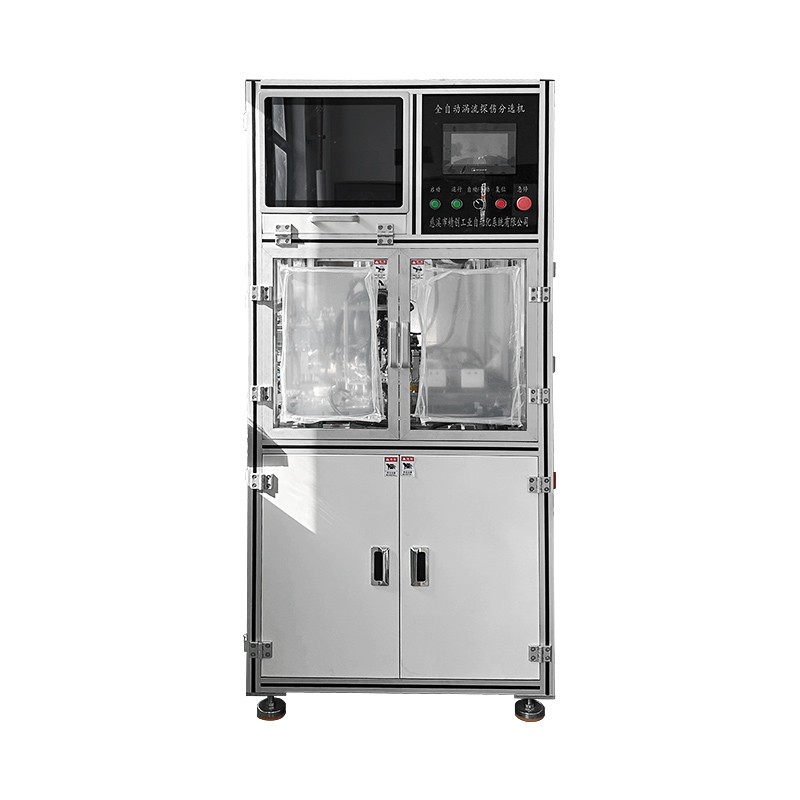Main technical performance of the equipment:
1. Sensitivity of flaw detection: cracks and defects that extend from the surface of the workpiece to the inside of the metal with a depth of ≥ 0.05mm and a length of ≥ 2mm; For cracks inside the metal that have not yet extended to the surface of the workpiece, cracks with a depth of ≥ 0.2mm and a length of ≥ 2mm can be detected when the metal thickness between the upper edge of the crack and the surface of the workpiece is ≤ 0.2mm.
2. Misjudgment rate: 0%, which means 99.99% of non-conforming products are removed; Misjudgment rate ≤ 1%. All rejected products can be retested once to reduce misjudgment.
3. Detection frequency range: 100Hz~1MHz, adjustable
4. Band pass filtering, center frequency 250-1000KHz, 8 levels
5. Gain: Each channel has a gain of 0-60dB, with an adjustment of 1dB per level
6. Phase: 0 °~360 °, with a step distance of 1 °
Principle of eddy current testing:
Eddy current detection is the application of electromagnetic induction principle, which excites the probe coil with a sine wave current. When the probe approaches the metal surface, the alternating magnetic field around the coil generates induced current on the metal surface. For flat metal, the direction of induced current is a concentric circular coil, resembling a vortex, called an eddy current. At the same time, eddy currents also generate a magnetic field of the same frequency, which is opposite to the direction of the coil magnetic field. The loss resistance of the eddy current channel, as well as the anti magnetic flux generated by the eddy current, are reflected back to the probe coil, changing the current magnitude and phase of the coil, that is, changing the impedance of the coil. Therefore, when the probe moves on the metal surface and encounters defects or changes in material, size, etc., the reaction of the eddy current magnetic field on the coil is different, causing changes in the coil impedance. By measuring this change with an eddy current detection instrument, the presence of defects or other physical and material changes on the metal surface can be identified. There are many factors that affect the eddy current field, such as the degree of coupling between the probe coil and the tested material, the shape and size of the material, conductivity, permeability, and defects. Therefore, the principle of eddy current can be used to solve problems such as metal material inspection, thickness measurement, and sorting
Technical parameters:
Sensitivity of flaw detection: cracks and defects that extend from the surface of the workpiece to the inside of the metal with a depth of ≥ 0.05 mm and a length of ≥ 2 mm; For cracks inside the metal that have not yet extended to the surface of the workpiece, cracks with a depth of ≥ 0.20mm and a length of ≥ 1mm can be detected when the metal thickness between the upper edge of the crack and the surface of the workpiece is ≤ 0.2 mm.
The EM series product magnetic saturation state device is a professional design scheme used for eddy current testing of steel pipes in fluid environments. It consists of a magnetic saturator and a magnetized constant current power supply. The basic magnetic saturator consists of a magnetizing electromagnetic coil and iron prefabricated components, with a large volume and clean weight. It is suitable for use in fixed fixed sites in steel pipe manufacturing factories. In such situations, the ultrasonic testing device for castings in the magnetic saturation state does not need to be moved, and the volume and net weight do not need to be considered. Therefore, general raw materials can be used to make it to control costs. For customers who use steel pipes in power plants, petrochemical plants, etc., eddy current testing of steel pipes is generally conducted on the spot of fluidity, rather than in the production workshop. For the convenience of application and movement, the device is lightweight. For this matter, the professional design scheme for the EM series product magnetic saturation state device has been adopted, and an effective compact design scheme has been selected. High permeability raw materials and careful production and processing have further improved the magnetization efficiency of the device, resulting in a net weight of only 40% of the general device and a volume reduction of half. In addition, the magnetized switch power supply adopts a constant current power supply with a voltage regulator, which can effectively prevent the drawbacks of changing the magnetizing current due to changes in working voltage or overheating of the magnetizing electromagnetic coil, causing an increase in the resistor.
|


